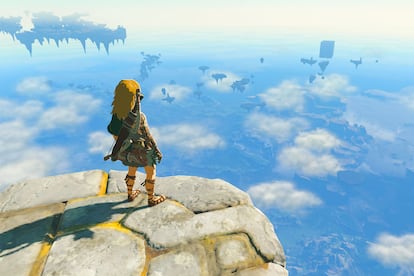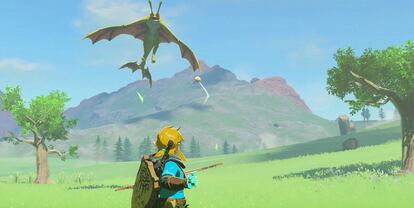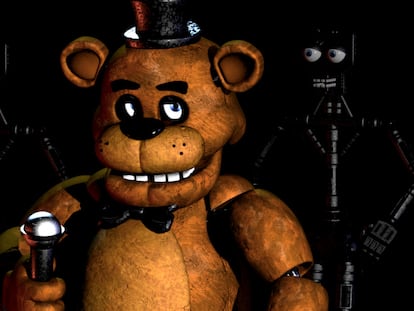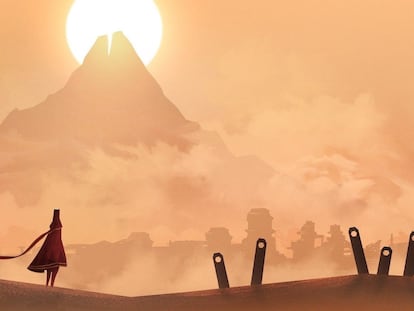Is ‘The Legend of Zelda: Tears of the Kingdom’ really the best video game in history?
A ground-breaking game of immeasurable depth, the latest installment in the Nintendo series has been a hit

It has sold 10 million copies in three days and has caused a sensation in the digital world. Plenty are now proclaiming it the greatest video game ever made. But is The Legend of Zelda: Tears of the Kingdom really that good? Let’s take a look.
In 2017, The Legend of Zelda: Breath of the Wild was released, and revolutionized Nintendo’s flagship adventure saga. It established itself as a firm candidate for best-game-in-history status. In general terms, the major change from previous installments of the Zelda franchise was that the hero, Link, no longer found himself inside the game’s traditional structure, comprising a series of dungeons; he was now in an open world that the player had complete freedom to explore as they completed the adventure. Greater weight was given to aesthetics and storyline than in other iterations of the game, but it was the switch to an open world that was the truly revolutionary move. There are now many video games with open worlds — but this one was special.
Generally speaking, video games can be either linear or take place in an open world. In a linear game, the player is sent from point A to point B, while in an open world, you are given scope to experiment. In the former, the narration follows a traditional course, as in a book or a movie; a story unfolds in a single direction. But in good open-world games, it is the player’s actions that build the narrative. It’s said that the video game is the most collaborative creative format out there, turning the player into co-creator; if so, nowhere is this more effectively illustrated than in the best open-world games. A classic example of this is Grand Theft Auto, a game in which the player can carry out missions as part of the pre-determined storyline… or spend time driving around, robbing stores and covering every inch of the map. In short: you can write your own story.
In 2017, Breath of the Wild took the idea of linear versus open-world to the next level, by fusing them. The key to the game was a concept that was so simple, yet so tough to pull off: make the whole world one big dungeon. So in the gigantic kingdom of Hyrule, plains and mountains were not there simply to fill out the map, as is the case in other games that allow the player complete freedom; rather, every single place had a reason for being there. It’s something that was left unsaid — there was no need for any of the characters to tell you where to go — because, in every corner of the game’s world, something caught your eye: a tower, something shining at the top of a hill, one of the 120 temples where there was a test to be completed. But, and this is the crux of the matter, when you went to a place that caught your eye, you found characters, enemies, collectables and challenges that weren’t distributed randomly, but were placed there by a designer who, in the shadows, controlled the gaming experience.
Ostensibly, you had total freedom, but delve a little deeper and you found that this freedom was kept on a leash to offer a more fulfilling experience. You could play the game however you liked, but in the end, most gamers ended up having a similar experience. What’s more, Breath of the Wild’s sounds and aesthetics were simply flawless, and its length and difficulty were perfectly judged.
Now, its sequel has arrived. And the question is: has The Legend of Zelda: Tears of the Kingdom been worth the wait?

After all, it was quite a wait. Six years is a long time to take to release a game that is built on the same technical foundations as the one before, and which reuses designs and much of the previous map. Well, that’s what people were saying before it came out, anyway. Now that it has dropped, nobody’s complaining.
Everything works like a dream, everything flows; the controls are so intuitive. The characters, of which there are dozens, each contribute to the overall picture. The story, which sees a return for Ganondorf, the game’s evil figure par excellence, is more fragmented, but is more complex and interesting. The map, which almost trebles in size with the addition of two new layers, feels more alive than ever before, more responsive. More than any other game, it urges the player to go and explore. Not out of obligation, but out of devotion: I want to go there, explore that cave, get to know that city or cross this body of water, because I know this isn’t all just window dressing; it’ll be worth it, and will enrich my experience.
The challenge of marrying style and substance is something we talk about in other art forms, too: for example, a novel could have a great story at its center, but it will only be a great novel if that story is told well, with prose that grabs you. When it comes to Zelda, its prose — and that of any video game — is its gameplay mechanics and feel. And, in Tears of the Kingdom, both are unbeatable. The new mechanics (which include a welding tool, the ability to breach ceilings, and hugely flexible weapon crafting) make for infinite game-playing possibilities. That’s no exaggeration. Each of the new temples (there are 152) throw up the perfect puzzle, a true intellectual challenge that we have to overcome with the elements that we have at our disposal. Across the game’s three map layers — the Depths, the Surface and the Sky — its makers’ philosophy is clear to see: we will be keeping an eye on you… But you can do whatever you want.
When the previous installment of Zelda came out, it was like going to the cinema in the 1940s and suddenly finding yourself watching The Godfather: it was a leap forward to decades ahead. Elden Ring, the best game in 2022, took leaves out of Breath of the Wild’s book, and went one step further. Now, in turn, Tears of the Kingdom has taken inspiration from Elden Ring (for example, by incorporating a subterranean world), in a demonstration of the fact that games communicate with one other; they influence each other’s mechanics, visuals, plot and level design. The video game is a living, evolving being, and this edition of Zelda illustrates that perhaps more than any other game.
I’ve said before that the video game conveys fear like no other medium (more than movies, more than novels). I can now also say that it’s the best at getting across a sense of adventure. In Tears of the Kingdom, you’ll find that feeling more than anywhere else: the threat of the monsters, the challenges of the dungeons, the danger that looms over the world; the stunning landscapes, the soft grass blowing in the wind, the complete freedom to explore. This iteration of Zelda has it all.
Every video game can aspire to be the best in history; why not? But the best games in history can only dream of being Tears of the Kingdom. It’s a game that does everything, does everything with ease, and does everything well.

Sign up for our weekly newsletter to get more English-language news coverage from EL PAÍS USA Edition
Tu suscripción se está usando en otro dispositivo
¿Quieres añadir otro usuario a tu suscripción?
Si continúas leyendo en este dispositivo, no se podrá leer en el otro.
FlechaTu suscripción se está usando en otro dispositivo y solo puedes acceder a EL PAÍS desde un dispositivo a la vez.
Si quieres compartir tu cuenta, cambia tu suscripción a la modalidad Premium, así podrás añadir otro usuario. Cada uno accederá con su propia cuenta de email, lo que os permitirá personalizar vuestra experiencia en EL PAÍS.
¿Tienes una suscripción de empresa? Accede aquí para contratar más cuentas.
En el caso de no saber quién está usando tu cuenta, te recomendamos cambiar tu contraseña aquí.
Si decides continuar compartiendo tu cuenta, este mensaje se mostrará en tu dispositivo y en el de la otra persona que está usando tu cuenta de forma indefinida, afectando a tu experiencia de lectura. Puedes consultar aquí los términos y condiciones de la suscripción digital.
More information
Archived In
Últimas noticias
Welcome to the post-religion era: The idea of Christianity as the absolute truth has become obsolete
‘I thought you would like it’: The risky sexual practice popularized by TV shows and TikTok
The digitalization of tourism: ‘They promise experiences and gave us the worst possible one’
Mexican peso defies uncertainty with forecasts of a new period of stability in 2026
Most viewed
- Sinaloa Cartel war is taking its toll on Los Chapitos
- Reinhard Genzel, Nobel laureate in physics: ‘One-minute videos will never give you the truth’
- Oona Chaplin: ‘I told James Cameron that I was living in a treehouse and starting a permaculture project with a friend’
- Why the price of coffee has skyrocketed: from Brazilian plantations to specialty coffee houses
- Silver prices are going crazy: This is what’s fueling the rally











































